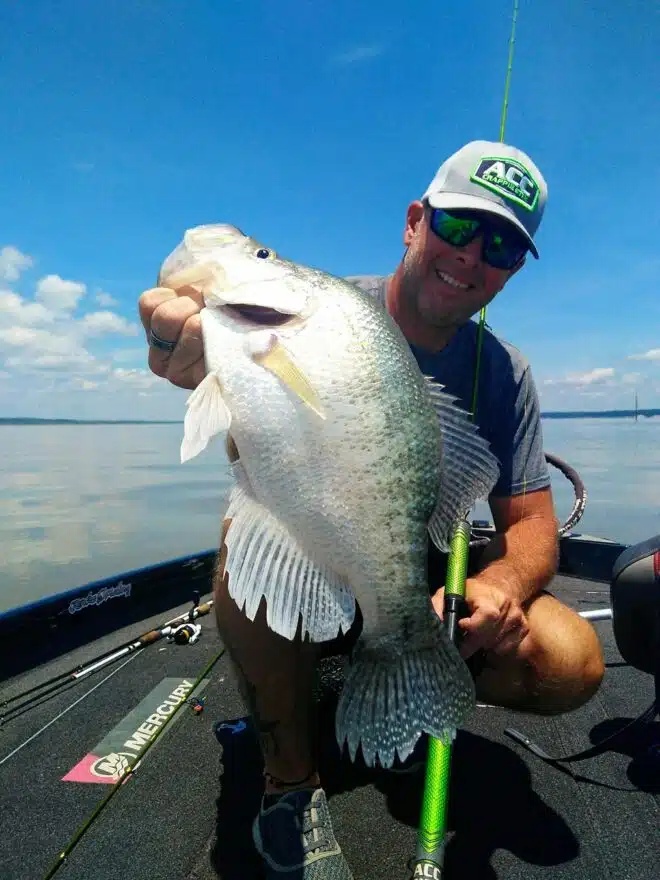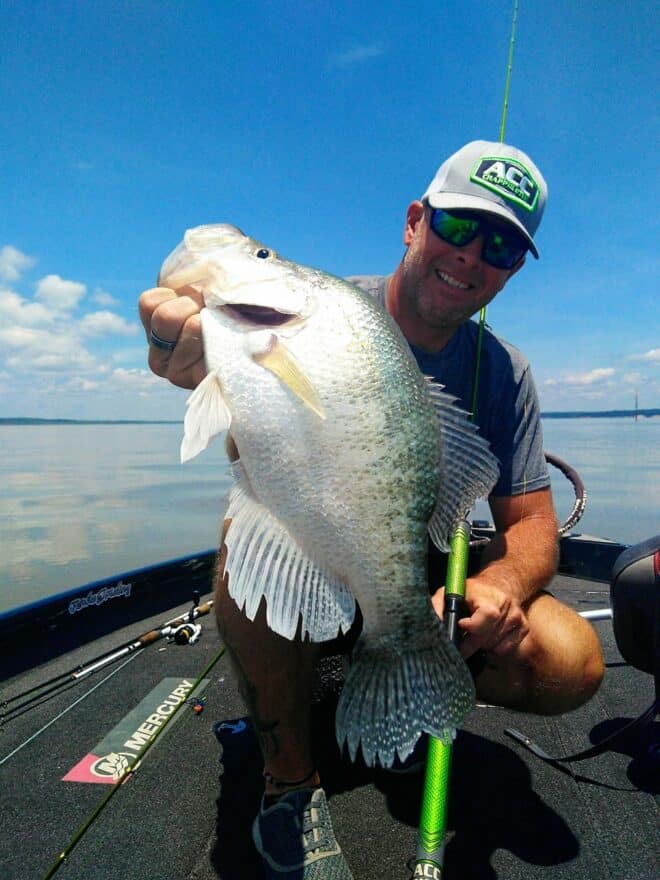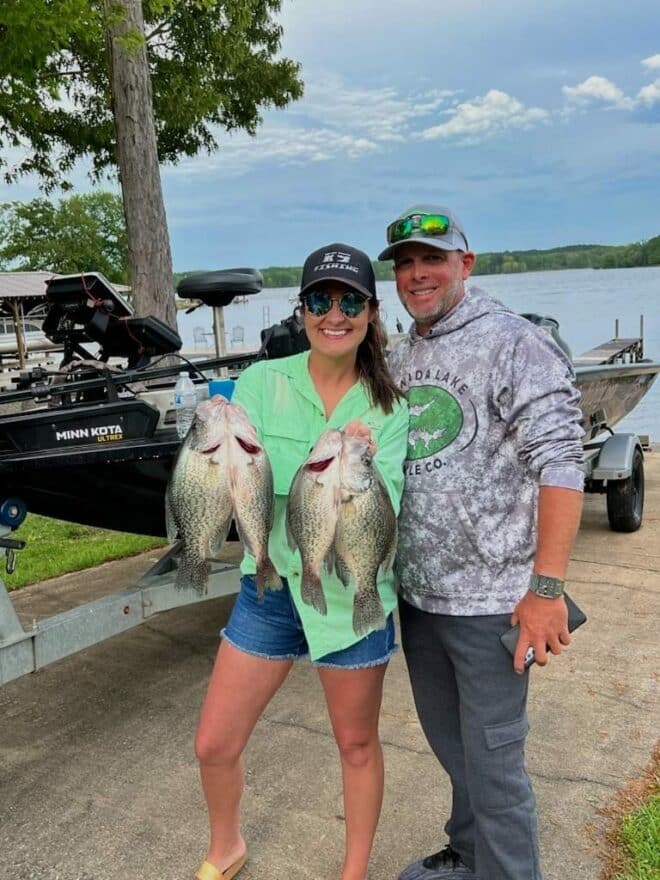5 Things about Triggering the Tough Bite with Jeff Jowers

By Greg McCain
The time arrives each year when the crappie bite turns tough. The easy limits of spring are replaced by fish recovering from the spawn, those spooking due to ultra-clear water, and some experiencing general lethargy.
So what does a crappie fisherman do in the late spring and summer months when the bite is difficult? We asked that question of ACC pro staffer and crappie guide Jeff Jowers, of Jemison, AL (call Southern Scale’s Guide Service, 256.294.9202, or follow the Southern Scale’s page on Facebook for information about guided trips on the Coosa River, which runs from northeast Alabama to near Montgomery; Jeff guides mainly on the lower Coosa lakes: Lay, Mitchell, and Jordan).
In late spring and the summer, Jeff focuses his personal fishing on moody post-spawn females, starting on the flats adjacent to spawning areas and later on main-river areas that hold fish. He said the males are usually grouped up and easier to catch, but the bigger females are his target and prove less predictable.
5 Things to Know about Triggering the Bite:
1. Jeff said first he’s “looking for dirty water. That’s going to be my goal. I’m going to the dirtiest water on whatever reservoir I’m on, and that’s where I’m going to start. It can be stained, but I try to avoid the ultra-clear water.” That’s easier said than done at times on the Coosa River, which features clear water except after major rain events in the region. The water clarity on the Coosa contrasts sharply with other fisheries in the central portion of the state like the Alabama and Tombigbee Rivers. Even a slight stain produces a better bite for Jeff.

2. A second key for Jeff is the ability to cast to the fish and determine what they want. The process requires precise casting and lure control. “I cast and bring the jig just above them,” he said. “I let them tell me what they want. They might follow a foot. They might follow all the way to the foot of the trolling motor before they commit or disappear. If they don’t (commit), I might downsize a little bit. There are times when I might upsize. I’ve had days when they wouldn’t touch a two-inch bait and then throw a three-inch swimbait, and they choke it. It depends on the mood that particular day.
“I’m not a super fan of changing colors. You don’t need a million colors. I think it’s profile (that triggers the bite). It needs to be something natural. I have a ‘million baits,’ but only one box. Everything in there is natural.”
3. Jeff continues the discussion with ideas about boat control. In particular, he said the shadow of the boat is always a consideration and contributes to a tough bite when crappie are 15 feet deep or less. “I don’t want them to see the shadow of the boat. I always pay attention to the angle that I’m approaching the fish and where the sun is. I don’t want that shadow to spook the fish. If I do, she’s going straight to the mud.”
A related idea involves dealing with the wind, which Jeff said he can work around. “I can’t work with the boat slap. I’ve seen those fish go straight to the bottom if you get too close with that boat slap. You have to adjust.” The adjustment mainly involves casting distance. Jeff said his perfect zone for casting is 35-40 feet. When the wind is howling, he might have to extend that distance to 45 feet or slightly more to avoid spooking fish and getting them to bite.

4. Jeff knows his local lakes intimately and fishes them accordingly. “You have to pick your spots,” he said. He adds that the bite may be non-existent on one lake or even one portion of a lake. The one thing that separates Lay from other Coosa impoundments is the volume of standing timber that it holds. Through years of experience, Jeff knows that the standing timber is the singular feature that produces fish conducive to feeding when the roamers are non-commital. “(Lay) is so much better and so much more versatile. I can fish standing timber in eight feet of water and standing timber in 30 that tops out at 15. In the dog days of summer, those fish will move to their summer patterns and get nose in to the timber in the deeper water right off the main river on the ledges. It still can be rough, but they will bite even when other fish on the lake are not in a feeding mood.”
5. A final point involves a philosophical decision, but one that is very much reality for Jeff and others when the crappie develop summer lockjaw. Do I use bait or not? Does Jeff use minnows? “In the dog days of summer, I probably wouldn’t leave home without them,” he said. “I might use a hand-tie or something different than the normal plastic to start with, but that’s when you go to the minnows.” Even then, Jeff said the bite can be tough and patience is a requisite for catching summer slabs. Normally, Jeff said he uses bait on deeper fish, at least 18 feet or more, and drops minnows vertically on them. “You might have to hold that minnow on their nose for a minute or it might take five minutes when she will nose up and take it,” he said. “Live bait is always an option when the bite is tough.”
Targeting warm-weather crappie can produce unique problems when it comes to triggering fish to bite. In fact, Jeff said, “It’s the hardest time of the year for me personally.” For greater success, identify the ideal portion of a lake in terms of water clarity and unique features like timber, pay attention to boat position, and change lures or transition to minnows. The result will likely mean greater success on the water when the crappie bite turns tough.













